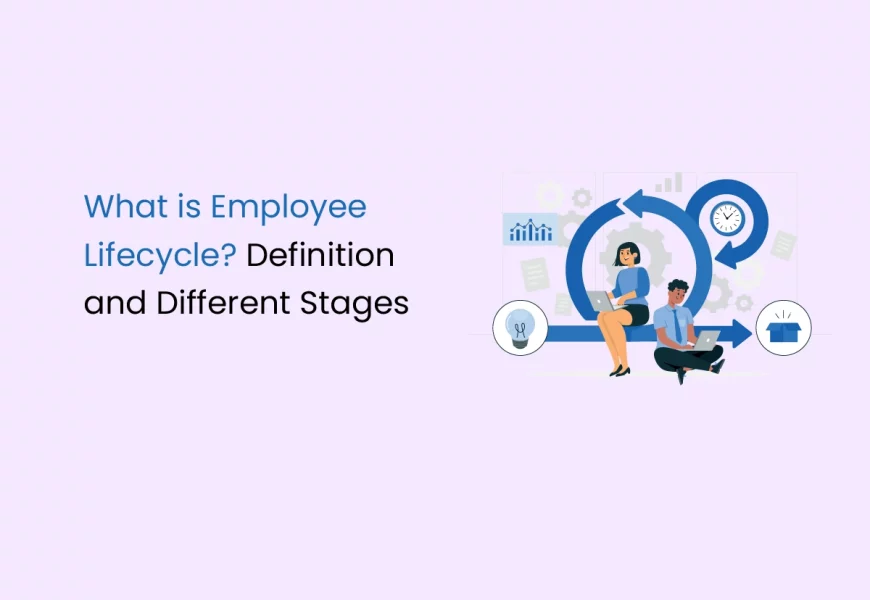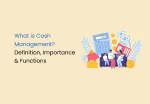Understanding the employee lifecycle and effectively engaging with individuals at each stage can help attract suitable candidates, enhance the overall employee experience, and ultimately boost organizational productivity and performance.
This blog delves into the employee lifecycle, its different stages and the advantages of an employee lifecycle model.
What is the Employee Lifecycle?
The employee lifecycle outlines the important phases an individual goes through while being employed by an organisation. It begins with the individual learning about the company, progresses through their time as an employee, and concludes once they depart from the organisation.
The stages of the employee lifecycle are as follows:
- Attraction
- Recruitment
- Onboarding
- Development
- Retention
- Offboarding
Stages of Employee Lifecycle
The stages of the employee lifecycle are as follows:
Attraction
The employee lifecycle begins with the attraction stage. No matter how innovative and strong a company’s product or service is, it will not succeed without attracting and retaining great talent. This makes the attraction stage one of the most critical aspects of any organisation’s growth strategy.
The attraction stage is the only stage before a company has an open position. It is also known as the employer brand, and it involves projecting the image of the organisation as a great place to work, both in the minds of current employees and key stakeholders in the external market. This means active and passive talent candidates, customers, clients, and potential stakeholders have a positive perspective of working within the company.
The following key tips can help establish a strong employer brand:
- Increase Brand Awareness: Encourage managers to participate in seminars and conferences, seek speaking opportunities, and contribute to popular industry publications. This will help enhance the company’s reputation as an appealing workplace.
- Cultivate a Great Company Culture: Creating a positive company culture is essential for both attracting and retaining talented employees. It is important to cultivate an environment where employees feel valued and appreciated. Encouraging team members to share their positive experiences within the company and leveraging social media platforms to highlight the positive aspects of the company culture to the public can significantly impact employee morale and the organisation’s reputation.
- Provide Competitive Benefits and Compensation: Offering competitive compensation is essential for attracting top talent. Additionally, consider providing unique benefits such as team lunches and flexible time off to make the company even more attractive to potential employees.
Recruitment
The second stage of the employee lifecycle involves employee recruitment, which is the phase dedicated to finding and hiring the most qualified individuals to join the organisation. This process may be triggered by the need to fill a vacant position or to create a new role. Effective recruitment strategies prioritise providing a positive experience for candidates, fostering collaborative hiring based on transparent criteria and procedures, and generating valuable data to enhance future hiring outcomes.
The following key tips can help an organisation during the recruitment stage:
- Use Employee Referrals: Encourage the current team members to refer potential candidates. However, it is advisable to avoid hiring close friends or family members of existing employees. Referrals often share similar values and are a valuable source of potential hires.
- Utilise Various Recruitment Platforms: Don’t limit the candidate pool to just one major recruitment website or media. Explore industry meetups and lesser-known industry publications to reach a wider audience of potential candidates.
- Be Specific in Job Postings: While casting a wider net can be useful, be specific about the prerequisites for the role to attract the most suitable candidates and save time for both parties.
- Involve Employees: Encourage employees to help define the requirements for the role and even assist in reviewing resumes and qualifications. Consider having someone in a similar role participate in the interview process to assess the candidates’ fit within the team.
Onboarding
The employee onboarding stage is the next phase in the employee lifecycle model. This stage is crucial for helping new hires adjust to the organisational environment and the performance aspects of their new role. During the onboarding stage, new employees delve into the intricacies of their position and identify the attitudes, knowledge, skills, and behaviours required to function effectively within the organisation.
Creating a welcoming environment and ensuring new hires are well-adjusted to their role and the organisation is essential for long-term engagement and contributions. Here are some key strategies to ensure a smooth onboarding stage:
- Provide a Clear Job Description: A lengthy, academic analysis of the job requirements is unnecessary when creating the outline. Instead, aim to craft a concise one-page outline highlighting the position’s key responsibilities and the relevant experience and skills required.
- Discuss the Company’s Vision and Values: When onboarding a new hire, it’s crucial to communicate the company’s values and vision. Discussing the significance of these values and vision with the new employee helps to ensure alignment with the company’s goals. It’s essential to clarify any questions and understand their perspective on how these values contribute to success.
- Outline Expectations Clearly: Even though the job description provides some details, it’s crucial to personally guide each new employee through the company’s expectations and explain why they are important for its success.
- Conduct Regular Follow-Ups: It’s important to note that completing the first week’s induction stage and leaving the new hires to fend for themselves can rapidly decline employee performance. It’s recommended to schedule face-to-face meetings with each new employee after a few weeks to check how they manage, any challenges they may have found integrating with the team, and so on. This approach can greatly support the new hire’s transition and overall performance.
Development
The employee development stage is the next phase in the employee lifecycle model. During this phase, consistently promoting professional growth among the team members is essential. This helps foster their skill development and provides them with a clear career path within the company.
To enhance the professional development stage of the employee lifecycle model, consider the following key tips:
- Encourage External Learning: Provide opportunities for the team to attend relevant conferences and seminars, which can greatly benefit their skill development. These opportunities are increasingly available as virtual offerings online. Consider covering the costs for such events or offering a company-covered budget for employee-initiated event attendance.
- Assess Knowledge and Skills collaboratively: Work with the employees directly to identify their key skills and areas of expertise. By leveraging their insights into their performance, the organisation can prioritise areas requiring further development, fostering an open, honest, feedback-driven relationship.
- Encourage Employees to Take Responsibility for Their Development: Encourage each team member to create a professional action plan to enhance their abilities and increase their career advancement chances. The HR department can collaborate with them on this process or provide a general template for the entire team to create their own plans.
- Recognise and Eeward Self-Directed Learning: Acknowledge and appreciate team members engaging in informal development activities outside their regular work hours. When aware of such efforts, it is best to take the time to express gratitude and ensure that these employees feel valued and appreciated.
Retention
The fifth stage of the lifecycle model is the employee retention stage, which focuses on keeping the top employees satisfied and challenged in their roles. Company culture plays a significant role in this stage; a poor culture often leads to high employee turnover and frequent replacement costs. Improving the retention stage helps counteract this risk and promotes longevity and satisfaction among the team.
Here are some tips to improve the employee retention stage:
- Hire the Right People: To retain top talent, attracting and recruiting the best individuals is essential. The quality of its hiring process can measure the success of the organisation’s attraction and retention efforts. Careful consideration in the initial hiring stages increases the likelihood of retaining the right employees in the team.
- Cultivate Great Relationships: Maintaining an open, honest, and respectful relationship with everyone on the team keeps them motivated and committed to the company.
- Communicate Organisational Mission and Team Aspirations: Aligning the team with the company’s mission and direction is crucial to enhancing employee retention. Regular communication about their roles and contributions to achieving the company’s goals is essential.
- Seek employee feedback and measure team morale frequently: For smaller businesses, holding a weekly in-person meeting with the team can be beneficial. This allows the company to review the team’s progress and address any challenges they may be encountering. Another helpful practice is conducting employee pulse surveys to gauge team morale and gather valuable feedback. Utilising shorter employee survey tools or implementing an online feedback mechanism can be especially effective for this purpose.
- Understand what Motivates Employees: It’s important to recognise that each employee is unique, and as a result, different things will motivate them to work hard. By understanding the individual motivations of the team members, the organisation can effectively engage and retain them.
Offboarding
The final stage of an employee’s journey within a company is the employee separation stage. At some point, an employee’s tenure with an organisation will end, whether due to retirement, pursuing new opportunities, or personal reasons. It’s crucial to treat the separation process with the same level of importance as the onboarding process and approach it strategically. When a team member leaves, it can impact the rest of the team.
The manager and HR professionals are responsible for ensuring that the departing employee exits in a way that minimises disruption. If a key employee unexpectedly leaves the organisation, there are several key tips to minimise the effects of the disruption:
- Understand the Reasoning Behind the Resignation: When an employee decides to leave their position, the reason they provide for their resignation may not always reflect the actual underlying factors. It’s crucial to delve deeper into the actual causes of the separation to gain insights that can help prevent similar situations from arising in the future.
- Remain Positive: Losing a highly skilled and valuable team member may evoke feelings of loss and uncertainty. However, it’s essential to recognise that while their departure may be impactful, it also presents an opportunity to welcome a new, exceptional employee to the team.
- Ask for Honest Feedback: When an individual departs from a company, it is crucial to conduct an exit interview. This process presents a prime opportunity to obtain candid feedback regarding the actual work environment and experience within the organisation.
- Remind the Team to Keep Looking Ahead: When a valued employee leaves, it can impact team morale. It’s essential to focus on reaffirming commitment to the remaining team members. Remind them that while the departure is disappointing, the team will ultimately recover and grow as a result.
Importance of the Employee Lifecycle
Managing the employee lifecycle is a critical responsibility of the HR department, as it involves overseeing the organisation’s most valuable asset: its employees. The lifecycle program provides employees with structured procedures throughout their tenure with the company while also allowing employers to gather and analyse data to drive continuous improvement. Ultimately, this approach can positively impact employee motivation, well-being, tenure, and overall performance.
How to Measure KPIs
Key performance indicators (KPIs) enable organisations to assess their progress towards achieving their goals. There are numerous measurable KPIs for each stage in the employee lifecycle. Still, not all of them are equally relevant to an organisation’s specific objectives for measuring and defining its employee lifecycle. These KPIs can be grouped into the following three categories:
Recruitment and Onboarding KPIs
Organisations need to track various metrics in addition to monitoring company ratings on platforms and tracking company interactions on social media.
Some of these metrics include:
- Cost Per Hire: This measures the average resources expended by the company to hire one employee.
- Time to Hire: This measures the average time the recruitment team takes to fill a position.
- Pre-Hire Surveys: These track the candidate’s experience with the recruitment process.
- Training surveys: These identify whether the new employee found the hiring process easy or difficult.
- Time to Productivity: This shows how long it takes for a new hire to reach productivity once they’re in their new role.
- New Hire Satisfaction: This measures the success of HR’s recruitment process.
Employee Engagement and Retention KPIs
- The employee retention rate is a metric that indicates the percentage of employees who remain with a company for at least one year.
- Internal promotion rates reflect the number of employees advancing within the company.
- Training return on investment assesses the effectiveness of training compared to its cost.
- Employee promotion progression gauges the career advancement of new hires within the company.
- Turnover measures the percentage of employees who voluntarily leave the organisation.
- Churnover tracks the movement of internal employees across different areas of the organisation.
- Satisfaction with benefits measures the level of employee contentment with the benefits provided by the company.
Offboarding KPIs
- When employees leave a company, exit interviews are used to understand the reasons behind their departure.
- The offboarding score assesses the effectiveness of the company’s offboarding process and determines if departing employees had a positive experience.
- The retirement rate indicates the number of individuals reaching retirement age and provides insight into its impact on the organisation.
- Status change processing measures the time it takes to process a termination.
Advantages of the Employee Lifecycle
Some of the advantages of an employee lifecycle model are as follows:
- Employee Engagement: Employee engagement measures employees’ emotional investment in an organisation and dedication to their work. The employee life cycle model is a valuable tool for organisations to enhance employee engagement by recognising, honouring, and fostering the development of each employee. It also enables employees to envision their potential long-term trajectory within the company, fostering a sense of commitment and loyalty.
- Talent Retention: The employee life cycle model is a valuable tool for organisations to optimise their resource allocation. It assists in identifying successful recruitment methods, which can lead to more effective hiring practices. Furthermore, the model aids in engaging and developing employees, fostering longer tenures within the organisation. This can ultimately decrease employee turnover rates and boost retention, reducing recruiting costs and labour demands.
- Reputation Improvement: Organisations can leverage their employee life cycle model and associated data to pinpoint areas for enhancement. By addressing these areas and employee concerns, organisations can improve their operations and bolster their reputation. This can lead to better talent acquisition and retention, fostering a more dedicated and motivated workforce.
Tips on Employee Lifecycle Management
The following are some tips on successful management of employee lifecycle in an organisation are as follows:
- Establish a strong employer brand: Highlighting the company’s values, culture, and benefits can help create a positive image of the organisation as an employer, which can help attract top talent.
- Promote a positive company culture on social media: Cultivating a supportive and inclusive workplace environment can enhance employee satisfaction. Sharing this openly can attract individuals who resonate with the organisation’s mission and vision.
- Develop a talent sourcing strategy: Plan strategically on how and where to source talent to ensure a consistent pipeline of talent to meet the organisation’s needs.
- Implement a competency-based interview process: Structuring interviews around specific competencies can help evaluate whether candidates’ skills and abilities align with the role’s requirements, leading to better hiring decisions.
- Prepare preboarding documents: Streamlining administrative tasks before a new employee’s first day allows for a smooth transition and minimises delays in the onboarding process.
- Establish a 30-60-90 day onboarding plan: Providing a structured onboarding plan can help new hires adapt to their roles and the company culture, setting them up for long-term success.
- Emphasise employee engagement: Actively involving employees in decision-making, recognising their contributions, and providing growth opportunities can foster loyalty, productivity, and retention.
- Utilise performance & reward processes for motivation: Offering meaningful recognition, rewards, and development opportunities based on performance can incentivise employees to excel and stay engaged.
- Align long-term development plans with business needs: Developing talent aligned with organisational goals ensures that employees have the skills needed to drive business success.
- Focus on leadership development and career growth: Investing in leadership development programs and career advancement opportunities empowers employees to reach their full potential and take on leadership roles within the organisation.
- Prepare for turnover: Having strategies to manage voluntary departures (e.g., career advancement) and involuntary separations (e.g., layoffs) can minimise disruption and support a smooth transition for all parties involved.
- Conduct exit interviews and surveys: Gathering feedback from departing employees through structured exit interviews can help identify areas for improvement and helpminn updating retention strategies.
- Engage former employees: Maintaining positive relationships with alumni can lead to valuable referrals, potential rehires, and insights into industry trends and competitors.
Conclusion
The employee lifecycle encompasses the stages an individual progresses through, from their initial awareness of an employer to their departure from the company. It is crucial to consider various factors at each stage of this journey, such as prospective employees’ impression of the company and the level of comfort and appreciation experienced by staff once they are on board. Employers can enhance their reputation by prioritising these considerations, leading to a more loyal and productive workforce.
Frequently Asked Questions
What are the six stages of the employee lifecycle?
The six stages are:
- Attraction
- Recruitment
- Onboarding
- Retention
- Development
- Separation
What is the HR lifecycle model?
The HR lifecycle, also known as the employee life cycle model, encompasses various stages such as attraction, recruitment, onboarding, retention, development, and separation. This terminology stems from the heavy involvement of the HR department in all these stages.
What are the pillars of employee experience?
Employers should focus on the five pillars of the employee experience, which include mental health, quality of life, growth, culture and values, and compensation and benefits. By prioritising these aspects, employers can create a positive work environment and foster loyalty among their staff.
Why is the employee life cycle important?
Understanding the employee life cycle and the various stages that employees go through enables the organisation to enhance each stage and improve the overall employee experience. This can lead to increased productivity and better business outcomes.
How to measure employee life cycle?
Measuring the employee life cycle at different stages can be done in various ways. For instance, tracking candidate demographics and career page analytics is one way to measure the attraction stage. At the recruitment stage, metrics such as candidate NPS, time to hire, and offer acceptance rate can be helpful. Time to productivity and new hire satisfaction are essential metrics for measuring the onboarding stage of the employee life cycle.














